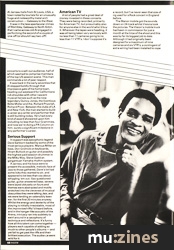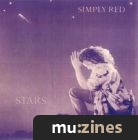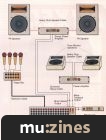Magazine Archive
Home -> Magazines -> Issues -> Articles in this issue -> View
PA Column | |
Al JarreauArticle from International Musician & Recording World, February 1985 | |
Al Jarreau's band itemised and analysed by Jim Betteridge
P.A. Column
| BAND: | Al Jarreau |
| VENUE: | Wembley Arena |
| DATE: | November 26, 1984 |
| PA: | Concert Sound |
Al Jarreau hails from St Louis, USA, a town noted by tourists for an unusually huge and noteworthy metal arch construction — Gateway to the West.
It was in the less spectacular climes of Wembley, Gateway to North Acton, that I came across old Al engaged in performing the second of a couple of one-off (or should I say two-off) concerts to a sell-out audience, half of which seemed to comprise members of the top US session scene. This man commands a lot of peer respect.

It was back in the early seventies that Al stepped boldly through that impressive gate of his hometown, heading out westward for California to rub shoulders with other nascent musical heroes such as the now legendary Quincy Jones, the licentious Bette Midler and the, Richard Pryorish, Richard Pryor. Between the clubs of LA and New York, the man started to build a career as a writer and performer that is still building today. He's had every kind of award showered upon him including no less than four Grammies, and now we're doing a PA Column on him; surely a significant milestone in any performer's career.
Serious Support
In support was saxophonic legend Dave Sanborn backed by some of the most serious players: Marcus Miller on bass, Don Grolnick on keyboards, Hiram Bullock on guitar and possibly the highest paid session drummer in the Milky Way, Steve Gadd on gargantuan Yamaha rhythm system.
If Jarreau and his boys were to present the accessible, melodic face of Jazz to those gathered, Dave's lot had some licks they wanted to air, and appeared to be less than coy about whipping 'em out: Sax questioned guitar, guitar answered bass; sevens were layed obtusely on fours and themes were abstracted and motifs stretched into the cleverest of musical obscurities they were talking Jazz, and we were lending an ostensibly keen ear; for the first 20 minutes anyway. Whilst the energy and dexterity of the playing is initially irresistible, most of the improvised riffs I'd heard before, and in the hanger-like acoustic of the Arena, intricacy ran into subtlety to swirl around in a cacophony of technique and reflections. It's funny how all this talent can come together — players each capable of adding so much to other people's albums — and yet fail to get past the riffs and their brilliant execution. The audience went wild for it.
American TV
A lot of people had a great deal of money invested in these concerts. They were being recorded, primarily for American TV, but presumably also for anyone else in the world who'd buy it. Wherever the tapes were heading, it was all being taken very seriously with no less than 11 cameras going to no less than 11 VTR's. I don't suppose it's a record, but I've never seen that size of rig used for a Rock concert in England before.
The Manor mobile got the sounds down on 24-track whilst Visions took the pictures. The Vision's mobile truck had been in commission for just a month at the time of the shoot and this was by far its biggest job to date. Although it had originally been designed for a maximum of nine cameras and six VTR's, a contingent of extra wiring had been installed to cope with any extended future requirements. Thus by utilising the space normally used for the storage of cameras in transit for extra VTR's, the truck was able to comfortably accomodate the extra facilities.
The original intention had been to shoot just the first night, but although the concert went well on stage, the audience had showed a little too much of the old British reserve, greeting the end of each number with polite bouts of clapping, and resorting to the dumb, awkward smile routine in reply to Al's attempts at free, interactive communication. Accordingly, they decided, at the last minute, to shoot the second night as well, and knowing that politeness is contagious, our star lost no time in the commencement of jiving with the crowd, who mercifully were a little less restrained than Sunday's collection. No doubt the results will reach British TV some time later this year.
Concert Sound
The components of the PA had been specified by the bands concerned, and hence not all the equipment was standard kit for PA hire company Concert Sound who, under normal circumstances, go almost exclusively for Midas/Martin rigs.
Front of house, each band had its own console requirements. In addition to a Soundcraft 32:8:2, the main man's outfit utilised a Soundcraft 16:2 just for the kit, the outputs of which were connected into two of the line inputs on the larger desk. The Sanborn heavyweights were channeled through a separate Midas 32:8:2. Both of the main consoles drove the same system through a pair of Klark Teknik DN27 graphics and a four-way BSS crossover.
True to Concert Sound form, the rig was mainly Martin, and comprised a flown system and a stage level system. The former was suspended in four separate cradles positioned in the shape of an arc to provide the wide lateral dispersion required at Wembley. The stage level system was actually identical in terms of components, except that there were fewer of them and the bass bins were single rather than double Martin 15's.
Bass: 12 2x15 double Martin folded horns
Lo Mid: 22 2x12 philishaves
Hi Mid: 24 JBL 2441's with Martin flares
Hi: 8 JBL 075's and 8 horn-loaded JBL 2420's
Stage Level System
Bass: 8 1x15 single Martin folded horns
Lo Mid: 4 2x12 philishaves
Hi Mid: 8 JBL 2441's with a Martin flare
Hi: 4 JBL 075's and 4 horn-loaded JBL 2420's
Both systems were driven four-way active via BSS crossovers, and apart from a DN300 inserted on Al's vocals, all graphics were Klark Teknik DN27, 1/3rd-octave. All amplifiers were Amcron DC300A's, which obviously have proven quality, although Concert Sound would normally use a combination of the various RSD bipolar and FET models.
A pair of Midas 24:10's drove a monitor system of 12 Martin LE200 wedges each with a DN27 graphic.
No surprises in the auxiliary racks which contained an Eventide H910 Harmoniser, a Lexicon Super Prime Time, Lexicon 200 and 224LX digital reverb units and a Roland Dimension D. In a separate 'insert' rack were 10 Drawmer gates, plus a Klark Teknik DN300 and a dbx 165 over-easy compressor, both of which were inserted on the lead vocals. The output rack contained a couple of DN27's, the crossovers and a pair of dbx 160's acting simply as line amps.
As with the rest of the rig, the mikes had been specified by Bob Goldstein, the band's engineer. The list was unusual in that it included a couple of AKG 441's for bass drum and snare — a specialist dynamic mike not often seen in this country and looking similar to the Sennheiser 441, but with a gold coloured tip to it. On drums was Ricky Lawson:
| Bass Drum | AKG 441 |
| Snare | AKG 441 |
| Hi Hat | Sennheiser 421 |
| 3Toms | 3x Sennheiser421's |
| Overheads | 2x AKG414's |
| Simmons | DI'd |
| Guitar | SM57 and DI (ChasJohnson) |
| Bass | DI (Nathan East) |
| Brass/sax | 2x Sennheiser421's (Michael Stewart/Michael Paulo) |
| Keyboards | DI (Bobby Lyle) |
| Acoustic Piano | 2xPZM's |
| All Vocals | Beyer M88's |
| Percussion | Secret method (Malando Gassama) |
Concert Sound were generally rather secretive about the way they did things, and even about the specific effect of said secretive things. They apparently used their own design of rumble LF/filter plus a 'secret' method of miking up the percussion. The sound was very good considering the dodgy acoustics, though no better than some other professional rigs that I've heard there. When you're pumping high level sound out from one end into a huge concrete box, with only people and a few suspended curtains to soak it up, there's gonna be confusion; and there was.
Al Slick
Al, the boys and the show were as slick as could be from start to finish. An impressively lit creation that looked like a cross between a butterfly and a bow tie was the centrepiece of a large scale cabaret-like set, amidst which the band members went variously berserk, dashing about the shop in spontaneous bouts of dance. I'm sure you couldn't get a place in Al's band unless you'd done a couple of years professional choreography. The arrangements were also like augmented cabaret scores; that's no criticism, they were bright, punchy and full with just enough space let the players lay their chops on the line without getting indulgent.
"There must be 9,000 people here", commented Jarreau. "That's good for me, I come from Ronnie Scotts. I'm gonna go and tell the people who hang out there where I've been tonight." He's still trying to keep the intimacy of a club gig as the venues get bigger and bigger, and in fact seems to be fairly successful, even if it did look like hard work at times. The future's looking good for the man from St Louis.
More with this topic
Live End - Simply Red: Two Shows In One |
Sounds good, John |
Splitting Image - Why Bands Break Up |
PA Column |
Live Sound - Introduction To PA (Part 1) |
A Day In The Life Of... - A Tour With Jethro Tull (Part 1) |
Son et Lumiere - Jean-Michel Jarre In Concert |
Live End - Do It Yourself with National Music Day (Part 1) |
 PA-Speak |
PA Column |
Say It Loud! - Power Amps and Loudspeakers |
Man from The Ministry - Ministry Of Sound |
Browse by Topic:
Live
Publisher: International Musician & Recording World - Cover Publications Ltd, Northern & Shell Ltd.
The current copyright owner/s of this content may differ from the originally published copyright notice.
More details on copyright ownership...
Feature by Jim Betteridge
Help Support The Things You Love
mu:zines is the result of thousands of hours of effort, and will require many thousands more going forward to reach our goals of getting all this content online.
If you value this resource, you can support this project - it really helps!
Donations for April 2024
Issues donated this month: 0
New issues that have been donated or scanned for us this month.
Funds donated this month: £7.00
All donations and support are gratefully appreciated - thank you.
Magazines Needed - Can You Help?
Do you have any of these magazine issues?
If so, and you can donate, lend or scan them to help complete our archive, please get in touch via the Contribute page - thanks!















